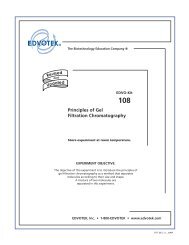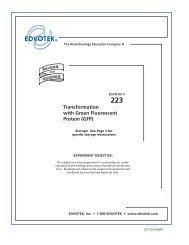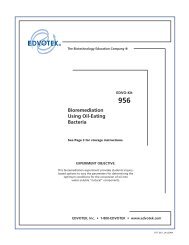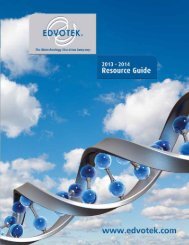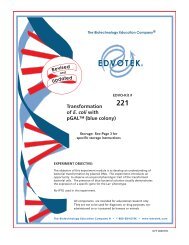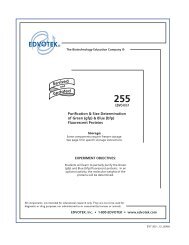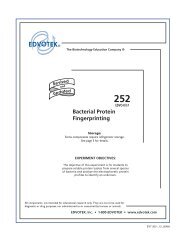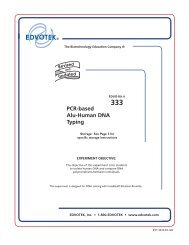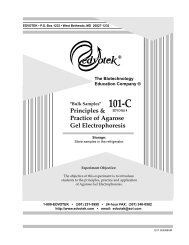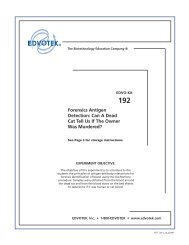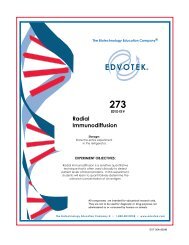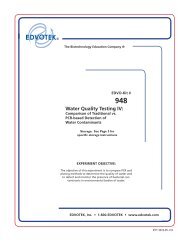953 - EDVOTEK
953 - EDVOTEK
953 - EDVOTEK
You also want an ePaper? Increase the reach of your titles
YUMPU automatically turns print PDFs into web optimized ePapers that Google loves.
6<br />
EDVO-Kit #<br />
<strong>953</strong><br />
Water Quality Testing III: Multiplex PCR Analysis for Water Contaminants<br />
Multiplex PCR Analysis for Water Contaminants<br />
Background Information<br />
As both point and nonpoint pollution eventually contaminate water sources<br />
used for drinking water, water treatment must effectively remove these<br />
impurities. While drinking water in U.S. cities is generally safe, several outbreaks<br />
still occur each year, making monitoring still necessary. Additionally,<br />
private well owners should also test water regularly for harmful chemicals,<br />
algae, and bacteria. Waterborne microbes such as Giardia and Cryptosporidium<br />
can cause severe, life-threatening illness if ingested in sufficient quantities<br />
(these are not actually bacteria but single-celled organisms called protists).<br />
Giardia and Cryptosporidium exist in the environment as cysts, hard,<br />
biologically inert spheres that begin to divide when ingested. Similarly, Salmonella<br />
and Shigella are two other (bacterial) waterborne pathogens that<br />
can cause community-wide infectious disease. In particular, elderly people<br />
or those afflicted with AIDS, cancer, and other diseases can have weakened<br />
immune systems that make them more vulnerable to such infections.<br />
Because testing for multiple organisms is time-consuming and prohibitively<br />
expensive, water is typically analyzed for the presence of a group of relatively<br />
harmless bacteria, known as coliform. Coliform bacteria are often used to<br />
indicate the presence of more harmful organisms and include bacteria such<br />
as Escherichia Coli (E. Coli), Klebsiella, Enterobacter, and Serratia. These organisms<br />
normally inhabit the intestine and gut of animals and humans. If a<br />
water sample is negative for coliform bacteria, it is assumed that more harmful<br />
organisms are also absent, and the water is deemed safe for drinking or<br />
swimming. In addition to the coliform test, a separate second test is often<br />
performed for E. Coli, whose presence could indicate fecal contamination.<br />
If a sample tests positive for E. Coli or coliform, it is often sent to a wellequipped<br />
laboratory that can perform more complex (and more expensive)<br />
tests to determine the specific (possibly pathogenic) organisms that might be<br />
present.<br />
One laboratory method that is now universally used to detect specific<br />
microorganisms is the polymerase chain reaction (PCR). PCR, invented in<br />
1986 by Dr. Kary Mullis at Cetus Corporation (for which he later received a<br />
Nobel Prize), has become invaluable for the amplification of specific DNA<br />
sequences. The basis for PCR is a heat-stable DNA polymerase (usually Taq<br />
polymerase) that can withstand near-boiling temperatures. Applications of<br />
PCR include genetic disease diagnosis, forensic identification, paternity testing,<br />
and detection of specific microorganisms (usually bacteria and viruses) in<br />
body fluids, soil, and water.<br />
Duplication of this document, in conjunction with use of accompanying reagents, is permitted for classroom/laboratory<br />
use only. This document, or any part, may not be reproduced or distributed for any other purpose without the<br />
written consent of <strong>EDVOTEK</strong>, Inc. Copyright © 2006, 2008, 2009 <strong>EDVOTEK</strong>, Inc., all rights reserved<br />
EVT 090205K<br />
The Biotechnology Education Company® • 1-800-<strong>EDVOTEK</strong> • www.edvotek.com




